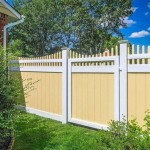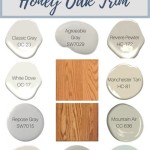What Color to Paint a Wooden Fence: A Comprehensive Guide
Choosing the right color to paint a wooden fence involves balancing aesthetic preferences with practical considerations. Beyond merely complementing a home's exterior, the color of a fence impacts its longevity, maintenance requirements, and overall visual appeal. This article explores the factors to consider when selecting a fence color, examines popular color choices, and provides insights into how different colors interact with the environment.
Considerations Before Choosing a Color
Several factors should be evaluated before deciding on a final color for a wooden fence. Ignoring these aspects can lead to dissatisfaction with the finished product or even compromise the fence's structural integrity.
Home Architecture and Landscape: The architectural style of the home and the surrounding landscape are paramount. A modern home might benefit from a sleek, contemporary color like dark gray or black, while a traditional cottage might look best with a classic white or natural wood stain. The color of the home's siding, trim, and roof should be considered to ensure visual harmony. Similarly, the colors prevalent in the surrounding landscape, such as the greenery of trees and shrubs or the vibrant hues of flower gardens, should be taken into account. A color that clashes with the natural environment can detract from the overall beauty of the property.
Privacy Needs and Visual Impact: The desired level of privacy and the overall visual impact are also important. Darker colors tend to visually recede, making a fence appear smaller and less imposing. This can be advantageous if the goal is to create a sense of spaciousness or to minimize the fence's presence. Conversely, lighter colors tend to stand out and draw attention to the fence. This can be desirable if the fence is a decorative element or if the aim is to create a strong visual barrier. In terms of privacy, darker colors can make it more difficult to see through small gaps or imperfections in the fence, which is helpful for enhancing privacy.
Sunlight Exposure and Climate: Sunlight exposure and the local climate play a significant role in how a fence color will appear over time. Darker colors absorb more heat from the sun, which can lead to the paint fading or cracking more quickly, especially in hot climates. Lighter colors reflect sunlight, helping to keep the fence cooler and prolonging the paint or stain's lifespan. In areas with high humidity or frequent rainfall, choosing a color that complements the surrounding vegetation can help the fence blend in with its environment, minimizing the appearance of mildew or algae growth. Furthermore, the angle of the sun can affect how a color is perceived, so it’s wise to observe the fence at different times of day to get a better sense of how the color will look under varying light conditions.
HOA Regulations and Local Ordinances: Before painting, confirm if the homeowner's association (HOA) has any rules regarding fence colors. Many HOAs have specific guidelines regarding acceptable colors to maintain uniformity and aesthetic appeal within the community. Additionally, research local ordinances to ensure compliance with any regulations regarding fence height, setbacks, or color restrictions. Failure to comply with these regulations can result in fines or the requirement to repaint the fence.
Popular Fence Color Choices and Their Implications
Numerous colors are suitable for wooden fences, each with its own aesthetic attributes and practical considerations.
White: White is a classic and versatile choice that complements a wide range of architectural styles. It creates a clean, bright, and inviting look. White fences are particularly popular in traditional and cottage-style homes. However, white fences require more frequent cleaning and maintenance, as they tend to show dirt, mildew, and other blemishes more easily than darker colors. Furthermore, white can be a stark color that might not blend well with natural surroundings unless softened by landscaping.
Natural Wood Stains: Natural wood stains enhance the inherent beauty of the wood grain, providing a warm and rustic aesthetic. They are available in a variety of shades, from light honey tones to deeper browns and reds. Natural stains allow the wood's texture to remain visible, which can be appealing to those who appreciate the natural look of wood. Stains typically offer better protection against moisture and UV damage than paint, as they penetrate the wood rather than forming a surface coating. However, regular re-staining is required to maintain the wood's appearance and prevent weathering.
Gray: Gray is a contemporary and sophisticated choice that works well with modern, minimalist, and farmhouse-style homes. It comes in a wide range of shades, from light and airy to dark and dramatic. Gray fences can blend seamlessly with natural surroundings, particularly in areas with rocky or muted landscapes. Gray is also a practical choice, as it tends to hide dirt and imperfections better than lighter colors. The versatility of gray allows it to be paired with a variety of accent colors, making it a flexible option for coordinating with the home's exterior.
Brown: Brown is a classic and earthy choice that complements a variety of architectural styles and landscapes. It provides a warm and inviting look and blends well with natural surroundings. Brown fences are a practical choice, as they tend to hide dirt and imperfections well. However, the specific shade of brown should be carefully chosen to avoid clashing with the home's exterior or looking dated. Lighter browns can create a more rustic feel, while darker browns can add a touch of elegance.
Black: Black fences make a bold and modern statement. They can add a touch of drama and sophistication to a property. Black fences work well with contemporary homes and can create a striking contrast against green landscapes. However, black fences absorb more heat than lighter colors, which can cause the paint to fade or crack more quickly, especially in hot climates. They also tend to show dust and dirt more easily than mid-tone colors. Despite these potential drawbacks, black fences can be a visually stunning choice for those seeking a modern and dramatic look.
Green: Green fences can blend seamlessly with natural surroundings, creating a harmonious and unobtrusive look. Lighter shades of green can add a touch of freshness and tranquility to a property, while darker shades can create a more earthy and natural feel. Green fences are a good choice for those who want to minimize the fence's visual impact and allow the landscape to take center stage. However, the specific shade of green should be carefully chosen to avoid clashing with the surrounding vegetation or looking dated.
Factors Affecting Color Longevity and Maintenance
The chosen color is not the only element affecting the fence's final look. Understanding how different paints interact with the wood and how environmental factors can affect the paint coat is crucial for the long-term maintenance and appearance of the fence.
Paint Type and Quality: The type and quality of paint play a significant role in the color's longevity and the frequency of maintenance. Exterior-grade paints formulated for wood are essential. These paints are designed to withstand the elements, including sunlight, rain, and temperature fluctuations. Acrylic latex paints are a popular choice due to their durability, flexibility, and ease of application. Oil-based paints offer excellent adhesion and moisture resistance but tend to yellow over time and require more effort to apply and clean. High-quality paints contain more pigments and binders, which provide better coverage, color retention, and protection against fading, cracking, and peeling.
Wood Preparation: Proper wood preparation is crucial for ensuring the paint adheres properly and lasts longer. Before painting, the wood should be thoroughly cleaned to remove dirt, mildew, and loose paint. Power washing can be an effective way to clean the fence, but care should be taken not to damage the wood. Any damaged or rotten wood should be replaced before painting. Priming the wood with a high-quality exterior primer is recommended, as it helps to seal the wood, improve paint adhesion, and prevent tannins from bleeding through the paint. Sanding the wood smooth before priming can also improve the paint's appearance and durability.
Application Techniques: The way the paint is applied can also affect its longevity and appearance. Applying multiple thin coats of paint is generally better than applying one thick coat, as it allows the paint to dry more evenly and prevents drips and runs. Using a brush, roller, or sprayer can achieve different results. Brushing can provide better control and allow the paint to be worked into the wood grain, while rolling can be faster and more efficient for larger areas. Spraying can provide a smooth and even finish but requires more skill and preparation. Regardless of the application method, it is important to follow the manufacturer's instructions carefully and to apply the paint in dry, temperate conditions to ensure proper curing.
Regular Maintenance: Regular maintenance is essential for preserving the fence's color and overall appearance. This includes cleaning the fence periodically to remove dirt, mildew, and other blemishes. A mild detergent and water solution can be used to clean the fence, followed by a thorough rinsing. Inspecting the fence regularly for signs of damage, such as cracks, splinters, or peeling paint, is also important. Any damaged areas should be repaired promptly to prevent further deterioration. Depending on the paint's durability and the local climate, the fence may need to be repainted every few years to maintain its color and protection.

5 Fence Paint Colors To Refresh Your Exterior Curb Appeal Wow 1 Day Painting

Fence Paint Colours

5 Fence Paint Colors To Refresh Your Exterior Curb Appeal Wow 1 Day Painting

14 Best Backyard Fence Color Ideas For Stain Or Paint

4 Tips For Choosing The Right Fence Color Secure And Rail

Do S And Don Ts For Choosing The Right Fence Colour Maria Killam

The Best Colours For Your Property Fencing

Wood Fence Painting And Staining Instructions Tips

Behr 1 Gal N520 2 Silver Bullet Solid Color House And Fence Exterior Wood Stain 01101 The Home Depot

14 Best Backyard Fence Color Ideas For Stain Or Paint
Related Posts








